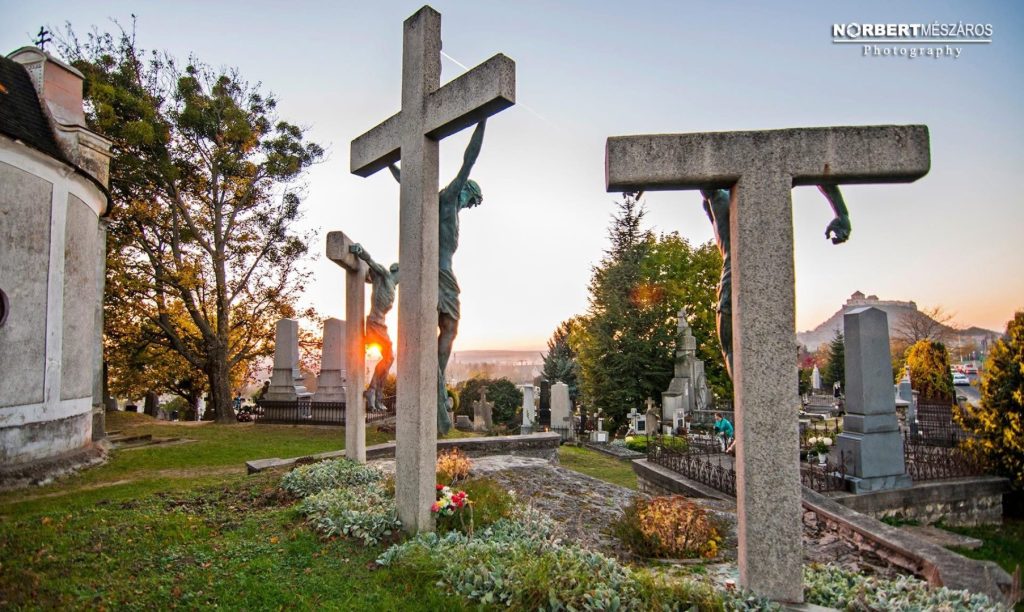It’s November 1, and instead of carving pumpkins or answering the doorbell to small vampires, Andrew and I are in Sümeg, where the hills are turning gold and the air smells faintly of woodsmoke. This weekend we’ve swapped Halloween chaos for candlelight calm. Hungary’s All Saints’ Day – followed by All Souls’ Day tomorrow – is unlike anything I grew up with in Canada. Here, cemeteries aren’t forgotten edges of town; they’re gathering places, carefully tended and quietly beautiful.
What Hungary Does on 1–2 November
Across the country, families visit cemeteries to honour loved ones. They sweep graves, plant chrysanthemums, and light candles that flicker well into the night. The result is mesmerising: rows of glowing lanterns stretching across headstones, like a constellation rooted to earth.
The two days differ slightly. November 1 (All Saints’ Day) is a national public holiday commemorating the saints and the sanctified—shops, banks, and many public offices close. November 2 (All Souls’ Day) is for everyone else who’s passed on, though it’s not an official holiday. In practice, the two merge into one long weekend of remembrance.
Church bells ring; village roads clog with parked cars; and even those who rarely attend mass still make their annual pilgrimage with flowers and candles in hand. For many Hungarians, it’s a moral ritual as much as a religious one.
A Nation That Still Lights a Candle
A recent national study confirms what’s plain to see tonight. The survey, titled “Taboos and Changing Customs Around Death,” commissioned by the National Funeral Society and Guild (OTEI), found that 56 percent of Hungarians visit cemeteries a few times a year – mostly on All Saints’ Day – while 31 percent tend graves regularly. Only 12 percent said they never visit at all, a number that rises to 22 percent in Budapest.
Perhaps more telling, nearly everyone considers cemetery upkeep important: 50 percent call it very important, 43 percent important, and only a single percent dismiss it as irrelevant. Those numbers say more about Hungarian values than any official decree. Here, remembrance isn’t outsourced; it’s a shared civic duty performed with polish and flowers.

Candlelit graves beneath autumn trees at Sümeg Cemetery on All Saints’ Day in Hungary. A glowing landscape of remembrance. © Norbert Mészáros Photography
When Halloween Meets Halottak Napja
Hungary hasn’t escaped the Halloween wave – far from it. Step into a Budapest café or doctor’s waiting room this week and you’ll see paper bats and plastic pumpkins. Eight years ago, you’d have found nothing of the sort. Halloween has gone from novelty to normal, especially in the capital, where themed parties and office decorations rival those back home.
And yet, Halottak Napja – the “Day of the Dead” in Hungarian – is still the real event. While North Americans dress up as ghosts, Hungarians quietly visit them. Instead of trick-or-treat buckets, there are chrysanthemums; instead of skeleton inflatables, a hush of candlelight. The contrast is profound: same season, same darkness, entirely different relationship with mortality.
For someone who grew up passing Toronto’s Park Lawn Cemetery every day, it’s oddly moving to see whole families strolling among headstones here – toddlers in wool hats, grandparents arm-in-arm, the living and the dead sharing the same evening air.
Joining In, Respectfully
If you find yourself in Hungary on these days, joining in is simple – and welcome. Buy candles or lanterns before November 1, as supermarkets and malls close for the holiday. Small kiosks near cemeteries stay open, selling wax candles and pots of chrysanthemums in every shade of gold.
Arrive before sunset to avoid traffic and watch the transformation as dusk falls. You don’t need to be religious; you just need to be considerate. Step carefully between plots, keep voices low, and never photograph people without permission.
Most cemeteries stay open late, often until 8 p.m., and extra buses run in major cities to handle the crowds. The Budapest Transport Centre (BKK) even sets up temporary cemetery routes each year – proof that this isn’t a fringe custom but a national migration of remembrance.

The sun sets behind the crucifixes at Sümeg Cemetery, casting a soft light across the town. A moment of peace between memory and faith. Photo: © Norbert Mészáros Photography
FAQ & Resources
Is All Saints’ Day a public holiday in Hungary?
Yes. November 1 is a national public holiday. Most shops, banks, and offices close. Essential services like petrol stations and some 0–24 shops remain open.
Do people also observe All Souls’ Day on November 2?
Yes, though it’s not an official holiday. Many families extend their cemetery visits or attend church services that evening.
Can foreigners or non-religious people take part?
Absolutely. Lighting a candle or placing flowers is seen as a gesture of respect, not a religious test. Just follow basic cemetery etiquette.
Where can I learn more about Hungarian public holidays?
See OfficeHolidays – Hungary Public Holidays 2025 for official dates and descriptions.

From above, the Sümeg Cemetery stretches toward the castle hill. A resting place framed by history, community, and the rhythm of the season. Photo: © Norbert Mészáros Photography
From Candlelight to Winter Nights
By nightfall, the Sümeg cemetery glows like an open-air cathedral. Andrew and I wander along gravel paths lined with lanterns, the scent of paraffin mixing with autumn leaves. Somewhere nearby, a bell tolls eight, and people begin to drift home – some wiping tears, others chatting softly about dinner plans.
I light a candle for my father and grandfather, who rest miles away in Budapest, and watch the flame settle into stillness. It’s a small act but a satisfying one: part gratitude, part belonging. As the candles burn down and November fully arrives, Hungary feels suspended between seasons – half memory, half anticipation, and for a moment, perfectly at peace.
A heartfelt thank you to Norbert Mészáros Photography for capturing these beautiful images of the Sümeg Cemetery – far better than anything my iPhone could manage.
Living in a new country is never simple, but it doesn’t have to be overwhelming. Sign up for my FREE monthly newsletter – the HOW TO HUNGARY Insider. Each month, I share the latest Hungary updates, expert advice, personal insights from someone who’s actually done it – and absolutely no hidden agendas. Real experience. Expert tips. One email a month.

Anikó Woods is a Canadian-Hungarian writer, technology specialist, and digital strategist who swapped Toronto traffic for Hungarian bureaucracy. She’s the creator of HOW TO HUNGARY: Budapest & Beyond. Since moving to Hungary in 2017, she’s been deep in the paperwork trenches – fact-checking, interviewing experts, and helping others make sense of the madness. Her writing turns chaos into clarity, with a few laughs (and wine recommendations) along the way.

I didn’t know any of this. It’s a nice tradition and good to see people remembering their deceased friends and family.
Thanks so much! It is indeed so different that what many of us are used to. I hope you get to see it yourself one day.